Copied
William H. Johnson, Historical Scene with Mary McLeod Bethune, ca. 1945, oil on paperboard, 37 1⁄2 x 28 1⁄2 in. (95.2 x 72.5 cm), Smithsonian American Art Museum, Gift of the Harmon Foundation, 1967.59.651
Copied
Artwork Details
- Title
- Historical Scene with Mary McLeod Bethune
- Artist
- Date
- ca. 1945
- Location
- Not on view
- Dimensions
- 37 1⁄2 x 28 1⁄2 in. (95.2 x 72.5 cm)
- Credit Line
- Gift of the Harmon Foundation
- Mediums
- Mediums Description
- oil on paperboard
- Classifications
- Subjects
- African American
- Occupation — education — student
- Animal — cattle
- Portrait female — Bethune, Mary McLeod
- Architecture
- Figure group
- Object Number
- 1967.59.651
Artwork Description
Exhibitions
March 8, 2024–September 10, 2024
William H. Johnson's Fighters for Freedom series from the mid-1940s is a tribute to African American activists, scientists, teachers, and performers as well as international leaders working to bring peace to the world.















